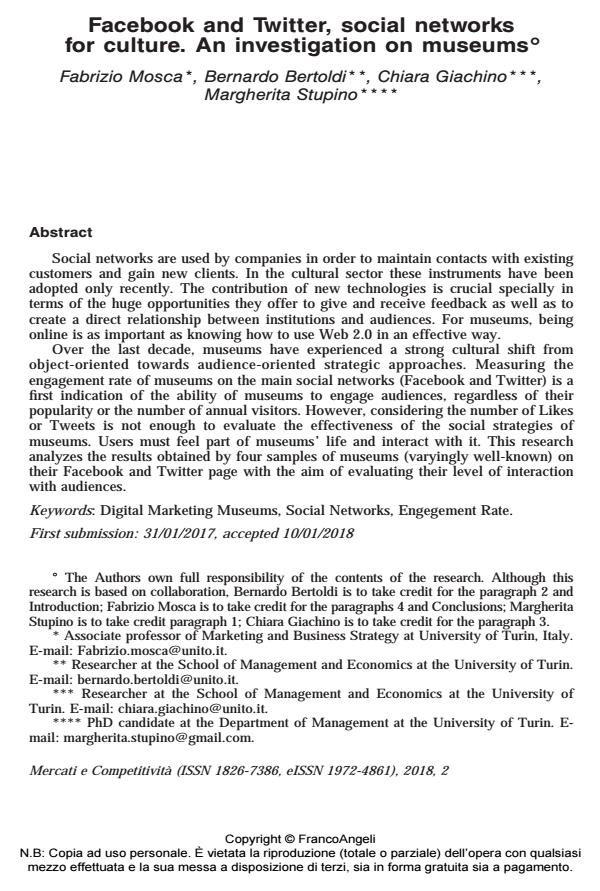Facebook and Twitter, social networks for culture. An investigation on museums
Journal title MERCATI & COMPETITIVITÀ
Author/s Fabrizio Mosca, Bernardo Bertoldi, Chiara Giachino, Margherita Stupino
Publishing Year 2018 Issue 2018/2
Language English Pages 21 P. 39-59 File size 495 KB
DOI 10.3280/MC2018-002003
DOI is like a bar code for intellectual property: to have more infomation
click here
Below, you can see the article first page
If you want to buy this article in PDF format, you can do it, following the instructions to buy download credits

FrancoAngeli is member of Publishers International Linking Association, Inc (PILA), a not-for-profit association which run the CrossRef service enabling links to and from online scholarly content.
Social networks are used by companies in order to maintain contacts with existing customers and gain new clients. In the cultural sector these instruments have been adopted only recently. The contribution of new technologies is crucial specially in terms of the huge opportunities they offer to give and receive feedback as well as to create a direct relationship between institutions and audiences. For museums, being online is as important as knowing how to use Web 2.0 in an effective way. Over the last decade, museums have experienced a strong cultural shift from object-oriented towards audience-oriented strategic approaches. Measuring the engagement rate of museums on the main social networks (Facebook and Twitter) is a first indication of the ability of museums to engage audiences, regardless of their popularity or the number of annual visitors. However, considering the number of Likes or Tweets is not enough to evaluate the effectiveness of the social strategies of museums. Users must feel part of museums’ life and interact with it. This research analyzes the results obtained by four samples of museums (varyingly well-known) on their Facebook and Twitter page with the aim of evaluating their level of interaction with audiences.
Keywords: Digital Marketing Museums, Social Networks, Engegement Rate.
- Creating Value through Social Media: Fresh Evidence from Cultural Organizations Cristina Caterina Amitrano, Roberta Gargiulo, Francesco Bifulco, in Journal of Creating Value /2018 pp.243
DOI: 10.1177/2394964318805616 - A Twitter network analysis of European museums Dimitrios Kydros, Vasiliki Vrana, in Museum Management and Curatorship /2021 pp.569
DOI: 10.1080/09647775.2021.1894475
Fabrizio Mosca, Bernardo Bertoldi, Chiara Giachino, Margherita Stupino, Facebook and Twitter, social networks for culture. An investigation on museums in "MERCATI & COMPETITIVITÀ" 2/2018, pp 39-59, DOI: 10.3280/MC2018-002003